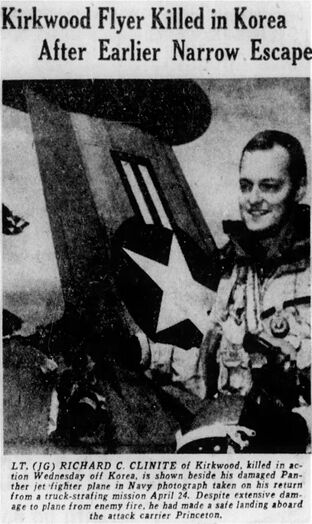RICHARD C. CLINITE, LTJG, USN
Richard Clinite '49
Lucky Bag
From the 1949 Lucky Bag:
Richard C. Clinite
Kirkwood, Missouri
Stretch completed high school with seven letters in football, basketball, and track, and the presidency of his class and the student council. He then attended New Mexico for two years in the ROTC, where his math work earned him a place in Kappa Mu Epsilon, his social standing a place in Sigma Chi, and his basketball a place on the starting five. Here it was not long before he won numerals in plebe basketball and crew, and graduated to a place on the varsity. In off moments, Stretch could be found lounging in his army B-robe, taking life easy, and planning a campaign to take him from the explorer class into the group that is settled. He has yet to decide what part of the service to enter, but, as he holds a private pilot's license, the air corps would be a good guess.

Richard C. Clinite
Kirkwood, Missouri
Stretch completed high school with seven letters in football, basketball, and track, and the presidency of his class and the student council. He then attended New Mexico for two years in the ROTC, where his math work earned him a place in Kappa Mu Epsilon, his social standing a place in Sigma Chi, and his basketball a place on the starting five. Here it was not long before he won numerals in plebe basketball and crew, and graduated to a place on the varsity. In off moments, Stretch could be found lounging in his army B-robe, taking life easy, and planning a campaign to take him from the explorer class into the group that is settled. He has yet to decide what part of the service to enter, but, as he holds a private pilot's license, the air corps would be a good guess.
Loss
Richard was killed in action when his F9F-5 Panther was shot down on May 13, 1953 by anti-aircraft artillery over Wonsan Harbor, Korea. He was a member of Fighter Squadron (VF) 153, operating from USS Princeton (CVA 37).
Other Information
From researcher Kathy Franz:
Richard graduated from Kirkwood High School. The 1944 yearbook wrote: “ . . . and Center Dick Clinite’s rebounds and set-ups, characterized the team play and netted for them honorable mention on the all district and berths on the all-suburban teams.” He was a member of the National Honor Society.
Richard married the former Camilla Smith on June 9, 1949, at Grace Episcopal Church in Kirkwood. Two of his ushers were Ensigns Walter Bradjeick and Robert Smith (both ’49.)
His first tour in Korea was from September 1951 to May 1952 in which he flew 78 missions. In his second tour, he was with FITRON 153.
He was survived by his wife and two daughters: Ann Gibson, age 3, and Cynthia Lee, 4 months. His father Wendell was superintendent of the Missouri Audit Bureau. His mother was Ann.
He was survived by his wife, Camila, and a daughter, Ann. (Information from August 1953 issue of Shipmate.)
Blue Tailed Fly
From the St. Louis Post-Dispatch, May 20, 1953, located by researcher Kathy Franz:
Reporter Sees St. Louisan’s Fatal Parachute Plunge Into Ocean
Writer Had Made Plans to Interview Lt. Richard C. Clinite Aboard CarrierBy John J. Casserly
ON AN ISLAND OFF NORTH KOREA, May 13 (delayed) (INS) – Death walked into the little island in North Korea today, tapped me on the shoulder and whispered a few words and was gone.
We were drinking a cup of hot coffee – Second Lt. Jim Day of Barstow, Calif., and I – and were talking about some of the marines we knew who died on Outpost Vegas a few months ago.
Suddenly a man shouted: “Parachute over the island.” We ran to the tent opening and raced to the crest of a hill. There he was – up about 10,000 feet, maybe more – jockeying in his chute and pitching at crazy angles in the high wind.
I watched his Pantherjet crash in the water to our right. The plane bobbed up and down for about 10 seconds and then its tail slipped down and disappeared.
“She’s Dead.”
Day, 28-year-old winner of four purple hearts, said, “She’s dead.”
The high wind carried the man in the chute far out from the island. It looked like he was fighting the wind all the way.
It was almost suppertime and I remembered I had promised to drink coffee and talk about the war with two Navy flyers – Lt. (jg) Robert R. King, 25, of Pomona, Calif., and Lt. (jg) Richard C. Clinite, 27, of Kirkwood, Mo. – aboard the carrier Princeton.
But orders came and I was shipped to this little island – far behind the Communist lines – just off the coast of North Korea.
Two United States Navy destroyers plowed through the rough seas heading out to rescue the falling flyer. After a long while, the white flap of the swaying chute faded and disappeared from sight.
We heard later the destroyers were too late. The pilot was found floating on the water dead.
His name, an officer said, was Lt. (j.g.) Richard C. Clinite of Kirkwood, Mo.
“No!”
“Yes,” the Navy officer said and turned away.
“We were going to have coffee together,” I said, and the officer turned to listen. “We had a date aboard the carrier. It was in Room 124 -- right at this time today!
“So you see,” I said, “that man parachuting over the island couldn’t have been Clinite. He’s waiting for King and me right now in Room 124 on the Princeton.”
“I Wrote About Him.”
There was a long pause and the officer looked away. I said:
“I just wrote a story about him and King – about a plane they flew called the Blue Tail Fly.”
“The man’s name was Richard C. Clinite,” the officer repeated.
(A Navy announcement said Lt. Clinite was dead when his body was picked up by the destroyer Samuel N. More.
“The announcement said stiff winds kept Lt. Clinite from collapsing his parachute after he hit the water, and the billowing parachute kept a helicopter from picking him up.)
The news of Lt. Clinite’s death was published last Friday in the Post-Dispatch. He is survived by his mother, Mrs. Wendell B. Clinite, 1027 Curran avenue, Kirkwood, and by his wife and two young daughters of Mountain View, Calif. Lt. Clinite was a graduate of the Naval Academy at Annapolis. His father died two years ago.
From iModeler.com:
USS Princeton’s deployment on the line at the beginning of her final Korean deployment in April-May 1953 saw nine pilots shot down, with seven of the nine killed or missing. Among the dead was Lt(jg) Richard “Stretch” Clinite of VF-153, who was part of one of the more interesting stories to come out of the war at this time, that of “the Bluetail Fly.”
Panther parts in this final period of the war were increasingly difficult to obtain, which combined with the losses and the high number of aircraft damaged by the increasingly-effective enemy anti-aircraft defenses meant that carrier maintenance personnel had to become creative when it came to keeping aircraft in commission. Clinite was assigned one of the F9F-5s in the experimental unpainted aluminum finish. On 5 May, the airplane was hit in the tail section by flak that resulted in heavy damage. At first, it seemed the Panther would be grounded until extensive repairs could be performed back in Japan. However, Ensign W.A. Wilds returned from a mission in a blue-painted airplane that sustained heavy flak damage to the forward fuselage. In an all-night session on the hangar deck, the maintenance crews took the tail from Wild’s blue Panther and mated it to Clinite’s silver airplane. The result was named “The Bluetail Fly,” and Clinite flew it on several missions until it was so badly damaged by flak on 12 May that it was permanently grounded for major repair.
On 13 May, Clinite flew another Panther that took a major flak hit during the mission that forced him to eject over the sea. Clinite drowned when the wind prevented collapse of his parachute and the rescue helicopter was unable to pull him to safety due to the billowing chute.
From All Hands information bulletin, August 1953, page 38:
Jet Built out of Salvage
A silver and blue F9F Panther jet is now operating over the skies of North Korea as part of Fighter Squadron 153 from the carrier USS Prince ton (CVA 37). Nicknamed the “Blue Tailed Fly” because of its silver body and blue tail, the odd-colored jet was not always one airplane.The “Blue Tailed Fly” had its beginning one afternoon when the jets from Princeton were flying a flak suppression mission over North Korea. As the flight dove into the target, it was met with a fierce barrage of enemy gunfire. One jet was hit in the tail while another received heavy damage to its nose.
Both damaged planes swerved off the attack and after perilous flights, during which both pilots had doubts they would make it, returned to the carrier. The planes were taken below decks; it looked as though neither plane would fly again since the structural damage appeared too serious.
However, Princeton's aircraft maintenance crew had other ideas. These men, whose job is keeping the carrier's planes in operating condition, are accustomed to improvising, modifying and manufacturing parts to keep aircraft in flying condition.
Working throughout the night, a crew of metalsmiths, electricians and mechanics dismantled the undamaged sections of the two planes and joined them together. Although the two jets weren't even the same model of F9F, the repair crews managed to create the “Blue Tailed Fly.”
Lieutenant (junior grade) Robert R. King flight-tested the fighter plane, checking to see if the “two-in-one” jet could withstand the structural strain this type aircraft must undergo. It could. The “Blue Tailed Fly” successfully completed 12 missions and is now back in the States for overhaul.
Through the ingenuity of the aircraft maintenance crew, one good airplane was made from what otherwise might have been a loss of both. The job represents a savings which is estimated at half a million dollars to the taxpayer.
Credit for the job goes to the various crews in Princeton's maintenance gang. In charge of the repair crews were Jim Wade, AEC, USN, Norwood Hyatt, ADC, USN; Charles Tanner, AMC, USN; Stanley Janowski, ADC, USN; and Carl Maag, ADC, USN.
Photographs

The "category" links below lead to lists of related Honorees; use them to explore further the service and sacrifice of alumni in Memorial Hall.

